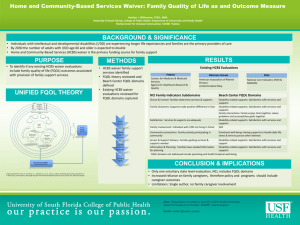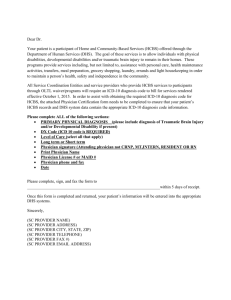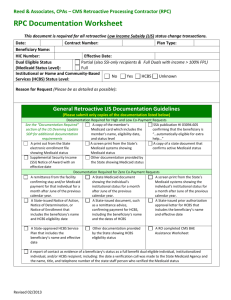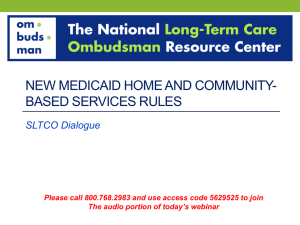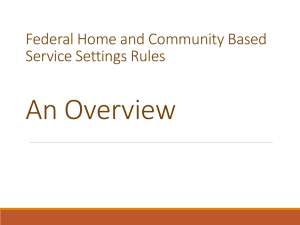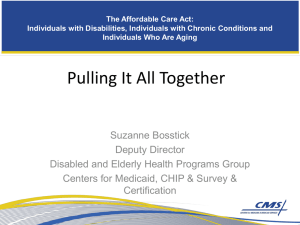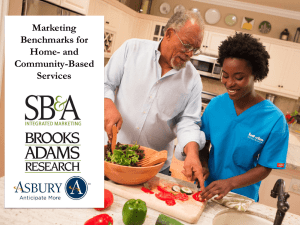Addressing Performance Measure Gaps in HCBS to Support
advertisement
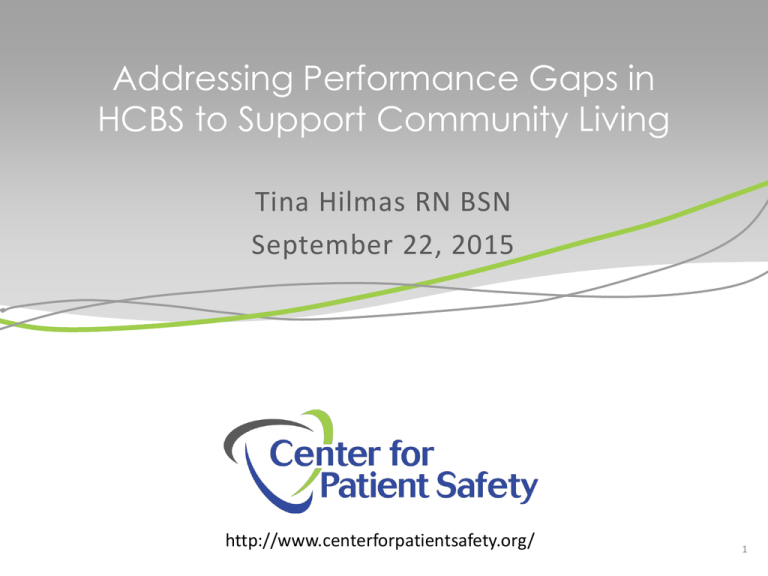
Addressing Performance Gaps in HCBS to Support Community Living Tina Hilmas RN BSN September 22, 2015 http://www.centerforpatientsafety.org/ 1 Center for Patient Safety • Federally-designated Patient Safety Organization • Not for Profit established in 2005 • Dedicated to promoting safe and quality healthcare through the reduction of errors • Our focus is on learning what errors occur, why they occur and how to prevent patient harm. We emphasize the importance of culture in promoting safe systems of care, culture that supports individualized care, teamwork and communication. • We work with licensed healthcare providers collaboratively to learn how to reduce serious events and patient harm within the federal confidentiality and privilege protections of the federal Patient Safety and Quality Improvement Act of 2005 2 Shameless Plug • Did you know that when analyzing home care patient safety events reported to the Center for Patient Safety that falls are the number one cause of a safety event in home care? • Beginning September 21, 2015 we start Falls Awareness Week • September 23rd is Falls Prevention Awareness Days • CPS is collaborating with Long Term Care to investigate falls with injuries in long term care facilities • Missouri is higher than the national average in regards to falls with injuries • Resources – – – – http://www.champ-program.org/page/99/falls-prevention-toolkit http://stopfalls.org/news-events/fall-prevention-awareness-week/ http://www.patientsafety.va.gov/professionals/onthejob/falls.asp http://www.cdc.gov/steadi/ 3 History/Need for Project • • Up until early 1980’s CMS was biased toward institutionalized care “Katie Beckett” Waiver (Tax Equity and Fiscal Responsibility Act - TEFRA) – Katie was 3 year old in Iowa who developed viral encephalitis which paralyzed her diaphragm which meant she required a vent for breathing and tube feedings as she couldn’t swallow – She gradually improved but would always have complex medical needs which lead to extreme costs – At the time (1981) the way the law regarding financial assistance was set up families had 1 of 2 options: • put the child in an institution in order to qualify for Medicaid • become impoverished – Katie’s story got the attention of President Reagan and in 1981 the Katie Beckett Waiver was created which allowed for Katie and children like her to qualify for Medicaid while receiving care at home – At same time many studies documented that at least 1/3 of Medicaid funded persons living in nursing homes could reside at home if additional support services were available. • Missouri was one of the first states to put this into effect in April 1982 4 Fast Forward and Fast Facts • Home and Community Based Services are increasingly coming under federal scrutiny • AHRQ (Agency for Healthcare Research and Quality) published Comparative Effectiveness Review article in November 2012 comparing HCBS to Institutional Care – Brought out the following facts: • Medicaid spending is rising faster for HCBS than for Nursing Homes • National Spending on HCBS from 1995 to 2009 more than doubled • Spending went from 19% in 1995 to 43% in 2009 – Results basically stated need for more research (see posters) – However, one major highlight was that it noted that outcome measures were not standardized across the settings • 2012 Commission on Long Term Care noted annual costs for long term care services were approximately $140 billion (34% of all Medicaid funding) • At that time close to half of the $140 billion was due to HCBS 5 Fast Forward and Fast Facts • CMS predicts that when today’s numbers are reconciled over half of long term care expenditures will be comprised of HCBS • Commission on Long Term Care recently met with Congress to discuss need for improvement in Long Term Care across all settings but with particular attention to the HCBS area • Currently there are no national standardized quality measures for the home and community based arena. (Those that are present are not readily available nor are they uniform/standardized across states) • With over half of long term care expenditures being put towards HCBS and with an average of 60% of Medicaid funding coming from federal dollars the need has become apparent for standardization and comprehensive quality performance measurements 6 Overview • November 2014 National Quality Forum (NQF)made a call for nomination for a multi-stakeholder committee to provide input on performance measurement gaps in home and community based services. • 2 year project under contract with the Department of Health and Human Services • States are continuing to shift resources from institutional care to HCBS • There is a need to ensure that a high quality HCBS system is in place to support elderly and disabled • NQF recognizes that HCBS are vital to promoting independence and wellness for people with long-term care needs – Focus on older adults and the disabled. – Recognize that efforts to measure and improve quality in HCBS are limited yet needed 7 Project Goals • Create a conceptual framework for measurement, including a definition for HCBS • A synthesis of evidence and environmental scan for measures and measure concepts • Identify gaps in HCBS quality measures based on the developed framework • Make recommendations for prioritization HCBS measure development efforts 8 Timeline of Project Phase 1: Initial evidence and environmental scanning of defined sources Starts Dec. 2014 Operational definition of HCBS and framework domains and subdomains development Phase 2: Tailored evidence and measure scanning based on domains/subdomains Spring/Summer 2015 Fall2015/Winter 2016 Committee analysis and prioritization of measure gaps Spring 2016 9 Project Reports REPORTS DUE DATES Draft Report: Operational Definition and Draft Conceptual Framework for HCBS Performance Measurement July 15, 2015 Draft Report: Environmental Scan of Measures and Synthesis of Evidence for HCBS November 15, 2015 Draft Report: Recommendations on HCBS Measure Concepts for Translation and Advancing Measurement July 15, 2016 Final Report: Recommendations on Addressing Performance Measure Gaps in HCBS to Support Community Living Quality September 4, 2016 10 Back to Basics • AHRQ began developing measures for HCBS about 8 years ago (http://www.ahrq.gov/professionals/systems/long-termcare/resources/hcbs/hcbsreport/index.html) • While it is a few years old, it was very thorough and included over 200 measures • NQF is using this report as a foundation to identify measures for HCBS • CMS has sponsored the development of a taxonomy for HCBS explaining types of and uses for HCBS which is to be implemented into the new version of the Medicaid Statistical Information System (MSIS) 11 Emerging Activities based on Project • Electronic service plans for long term supports and services (eLTSS) • CMS’s TEFT (Testing Experience and Functional Tools) is working on several tools: – HCBS consumer experience of care survey – Continuity Assessment Record and Evaluation (CARE) tool functional item set • Together these are setting the groundwork for an eLTSS health record and interoperability standards to exchange records across providers • For this to happen though must start with a standard definition. – Reviewed more than 200 information sources – Identified 27 different existing definitions of HCBS and LTSS 12 Operational Definition The term “home and community-based services” (HCBS) refers to an array of long-term supports that promote the independence, wellbeing and choices of an individual of any age who has physical, cognitive, and/or behavioral health needs and that are delivered in the home or other integrated community setting. 13 Characteristics of High Quality HCBS • These outline how services SHOULD be delivered • Define the importance of ensuring the adequacy of the workforce • The importance of integrating healthcare and social services • And lastly the importance of supporting the caregivers of those who utilize HCBS • These characteristics are also centered on fostering an HCBS system that is: – Ethical – Accountable – Centered on the achievement of an individual’s desired outcomes 14 Characteristics • Provides for a person-driven system that optimizes individual choice and control in the pursuit of self-identified goals (employment, enjoying life) • Promotes social connectedness by including people who use HCBS in the community to the same degree as people who do not use HCBS • Includes a flexible range of services that are accessible, appropriate, effective, sufficient, dependable, and timely to respond to individuals’ strengths, needs and preferences • Integrate health and social services to promote well-being • Protects the individual’s human and legal rights, including privacy; dignity; freedom from abuse, neglect and exploitation; respect; and independence • Ensures each individual can achieve the balance of personal safety and dignity of risk that he or she desires • Utilizes and supports a workforce that is trained, adquate, and culturally competent • Supports family caregivers 15 Characteristics • Engages individuals who use HCBS in the design, implementation and evaluation of the system and its performance • Reduces disparities by offering equitable access to and delivery of services • Coordinates and integrates resources to maximize affordability and long-term sustainability • Supplies valid, meaningful, integrated, aligned and accessible data • Fosters accountability through measurement and reporting of quality and outcomes • Other discussions – The degree to which traditional health services (doctor visit/hospital stays) should be integrated. • Coordination and integration are important • Avoid “over-medicalizing” – Concept of Safety and how to incorporate it in a manner that empowers the client/participant • Should be balanced with other goals • Not over-emphasized to a point that would diminish goals such as mobility/socialization • Should be individualized – How best to support paid and unpaid caregivers – Definition of Culturally Competent Services 16 Domains and Sub-Domains • The Domains listed in the following slide follow along with the characteristics of a high quality HCBS company . • The subdomains help to further define the Domains scope and help to clarify idea for measurement. • The Domains and Sub-Domains are still in the development phase and while the Domains have basically been agreed upon, further definition and clarification is what the committee is working on at the current moment. 17 Domains Domains for Measurement Description of Domain Workforce/Providers The adequacy and appropriateness of the provider network and HCBS workforce Consumer Voice The level of involvement that individuals who use HCBS have in the design, implementation, and evaluation of the HCBS system at all levels Choice and Control The level to which individuals who use HCBS are able to choose their services and control how those services are delivered Human and Legal Rights The level to which the human and legal rights of individuals who use HCBS are promoted and protected System Performance The level of accountability within the HCBS system and the extent to which it operates efficiently, ethically and is able to achieve desired outcomes Full Community Inclusion The level to which HCBS integrates individuals into their communities and fosters social connectedness Caregiver Support The level of support (i.e. financial, emotional, technical) available for the paid and unpaid caregivers of individuals who use HCBS Effectiveness/Quality of Services The level to which HCBS services are able to produce intended outcomes Service Delivery Aspects of services that enable a positive consumer experience (i.e. accessibility, respect, dependability, well-coordinated) Equity The level to which HCBS is equitably delivered and made available to a broad array of individuals who need long-term supports Health and Well-Being The level of integration between healthcare and other supportive services to promote holistic wellness 18 Sub-Domains Domains for Measurement Subdomains Corresponding to Each Domain Workforce/Providers Sufficient numbers and appropriately dispersed; dependability; respect for boundaries, privacy, consumer preferences and values, skilled, demonstrated competencies when appropriate; culturally competent, sensitive, mindful; adequately compensated (with benefits) safety of the worker; teamwork, good communications and value-based leadership Consumer Voice Meaningful mechanism for input (i.e. design, implementation, evaluation); consumer-driven system; breadth and depth of consumer participation; level of commitment to consumer involvement; diversity of consumer and workforce engagement Choice and Control Choice of program delivery models and provider(s), self-direction, particular worker (s) and setting(s); personal freedoms and dignity of risk; achieving individual goals and preferences (i.e. individuality, person-centered planning); self-direction; shared accountability Human and Legal Rights Delivery system promotes dignity and respect; privacy; informed consent; freedom from abuse and neglect; optimizing the preservation of legal and human rights; sense of safety; system responsiveness System Performance Consumer engagement; participatory program design; reliability; publicly available data; appropriate and fair resource allocation based on need; primarily judged by the aggregate of individual outcomes; waiting lists; backlog; financing and service delivery structures; availability of services; efficiency and evidence based practices; data integrity 19 Sub-Domains (con’t) Domains for Measurement Subdomains Corresponding to Each Domain Full Community Inclusion Enjoyment or fun; Employment; education, or productivity; social connectedness and relationships; social participation; resources to facilitate inclusion; choice of setting; accessibly built environment Caregiver Support Training and skill-building; access to resources (respite, crisis support); caregiver well-being (stress reduction, coping); caregiver and/or family assessment and planning; compensation Effectiveness/Quality of Services Goals and needs realized; preferences met; health outcomes achieved; technical skills assessed and monitored; technical services delivered; team performance; rebalancing Service Delivery Accessibility (geographic, economic, physical); appropriate (services aligned with needs and preferences); sufficiency (scope of services, capacity to meet existing and future demands); dependable (coverage, timeliness, workforce continuity, knowledge of needs and preference, competency) timely initiation of services; coordination of care (assessment, development of plan, information exchange between all member of the care team, implementation of the plan and evaluation) Equity Reduction in health and service disparities; transparency of resource allocation, access or waiting list; safe accessible and affordable housing; availability, timeliness, consistency across jurisdictions Health and Well-Being Physical , emotional and cognitive functioning; social well-being, spirituality; safety and risk as defined by consumer; freedom from abuse, neglect and exploitation; health status and wellness (prevention, management of multiple chronic conditions); behavioral health 20 Visual Conceptual Framework 21 Next Phase • Identify existing measures applicable to HCBS, with an emphasis on those that map to the conceptual framework’s domains and subdomains • Identify examples of HCBS quality measures to guide Committee discussion of implementation barriers and mitigation strategies (a selection of measures that can lend themselves to examination as ‘test cases’) • Identify measure concepts and ideas that should be further developed into future performance measures that will best support community living quality 22 Odds and Ends • Stated that while surveys from individuals regarding experience with care (i.e. HHCAHPS) alone do not constitute a performance measure, could utilize aggregated data from these types of tools • It has not been stated or proposed at the current time that reimbursement be tied in with quality 23 Questions 24 Resources • National Quality Forum: Measuring HCBS Quality – http://www.qualityforum.org/Measuring_HCBS_Quality.aspx • AARP Public Policy Institute: State Studies Find Home and Community Based Services to Be Cost-Effective – http://www.aarp.org/content/dam/aarp/research/public_policy_institute /ltc/2013/state-studies-find-hcbs-cost-effective-spotlight-AARP-ppi-ltc.pdf • HCBS Quality Measures Summit – http://www.medicaid.gov/medicaid-chip-program-information/bytopics/quality-of-care/downloads/quality-summit-2014.pdf • AHRQ: Environmental Scan of Measures for Medicaid Title XIX Home and Community-Based Services – http://www.ahrq.gov/professionals/systems/long-termcare/resources/hcbs/hcbsreport/index.html 25
